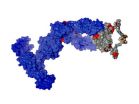(Press-News.org) A new University of British Columbia study identifies when the clock runs out on an NHL player's peak performance, giving team executives insight into how best to build a roster.
The study by Sauder School of Business professor James Brander found that the performance of forwards peaks between the ages of 27 and 28. Defencemen are best between 28 and 29, and the performance of goaltenders varies little by age.
The forthcoming study to be published in the Journal of Quantitative Analysis in Sports also reveals that players performed close to their peak levels for a number of years before and after their optimal peak: 24 to 32 for forwards and 24 to 34 for defencemen.
"While confirming conventional wisdom that players peak in their late 20s, the study proves it is wishful thinking for managers to expect a player in his mid-20s to continue improving significantly," says Brander, an economist. "The vast majority of players are at 90 per cent of their best by age 24, although there are a few late bloomers."
For the study, researchers used statistical models to estimate a typical player's career arc.
Brander says his numbers are reinforced by the current outcome of the Stanley Cup playoffs, with key players like Patrick Kane and Jonathan Toews of the Chicago Blackhawks in the prime age range. But he stops short of predicting the ultimate victor based on his study.
"If we just go by relative age of key players, a team like Chicago would appear to be in the best shape. But that's far from the whole story in the playoffs. Other things have a big effect, such as injuries and luck," he says.
INFORMATION:
Background:
The study is based on stats from the 1997-98 to 2011-12 seasons, considers 2,033 players and a total of 9,901 player years. The researchers looked at points per game played and plus-minus statistics. For goaltenders, they analyzed save percentage.
The study, Estimating the effects of age on NHL player performance, was co-authored by Edward Egan of the National Bureau of Economic Research and Sauder School of Business student Louisa Yeung.
Most NHL players peak by age 29: Study
2014-05-15
ELSE PRESS RELEASES FROM THIS DATE:
Learning from sharks
2014-05-15
This news release is available in German.
Custom-tailored antibodies are regarded as promising weapons against a multitude of serious illnesses. Since they can accurately recognize specific structures on the surface of viruses, bacteria or cancer cells, they are already being deployed successfully in cancer diagnostics and therapy, as well as against numerous other diseases. The stability of the sensitive antibodies is a decisive factor in every step, from production and storage to therapeutic application.
A team of researchers headed by Dr. Matthias J. Feige and ...
Where have all the mitochondria gone?
2014-05-15
It's common knowledge that all organisms inherit their mitochondria – the cell's "power plants" – from their mothers. But what happens to all the father's mitochondria? Surprisingly, how – and why – paternal mitochondria are prevented from getting passed on to their offspring after fertilization is still shrouded in mystery; the only thing that's certain is that there must be a compelling reason, seeing as this phenomenon has been conserved throughout evolution.
Now, Dr. Eli Arama and a team in the Weizmann Institute's Molecular Genetics Department have discovered special ...
Sugar implicated in cardiovascular disease risk independent of weight gain
2014-05-15
Researchers from New Zealand's University of Otago have uncovered evidence that sugar has a direct effect on risk factors for heart disease, and is likely to impact on blood pressure, independent of weight gain.
Research Fellow with Otago's Department of Human Nutrition Dr Lisa Te Morenga, Professor Jim Mann and colleagues have conducted a review and meta-analysis of all international studies that compared the effects of higher versus lower added sugar consumption on blood pressure and lipids (blood fats or cholesterol) – both of which are important cardiovascular risk-factors.
They ...
This is your brain on meditation
2014-05-15
Mindfulness. Zen. Acem. Meditation drumming. Chakra. Buddhist and transcendental meditation. There are countless ways of meditating, but the purpose behind them all remains basically the same: more peace, less stress, better concentration, greater self-awareness and better processing of thoughts and feelings.
But which of these techniques should a poor stressed-out wretch choose? What does the research say? Very little – at least until now.
A team of researchers at the Norwegian University of Science and Technology (NTNU), the University of Oslo and the University ...
HIV patient nutrition more vital than once assumed
2014-05-15
Roughly 25 million Africans live with HIV, many of who now have access to antiretroviral drugs (ARVs). Among their side effects, ARVs can cause patients to put on weight. Subsequently, attention paid to malnutrition among African HIV patients has waned. However, widespread malnutrition has been identified as a reason that up to a quarter of HIV patients in a number of African countries die just months after beginning medical treatment.
A collaborative project between the University of Copenhagen and Jimma University, Ethiopia has demonstrated that daily nutritional supplementation ...
The state of rain
2014-05-15
Using modern weather satellites to monitor rainfall has become a robust, widely practiced technique. However, establishing a reliable context for relating space-based rainfall observations to current and historical ground-based rainfall data has been difficult.
A new dataset developed in partnership between UC Santa Barbara and the U.S. Geological Survey (USGS) can be used for environmental monitoring and drought early warning. The Climate Hazards Group Infrared Precipitation with Stations (CHIRPS), a collaboration between UCSB's Climate Hazards Group and USGS's Earth ...
Study finds hazardous flame retardants in preschools
2014-05-15
Berkeley — A new study of preschools and day care centers finds that flame retardants are prevalent indoors, potentially exposing young children to chemicals known to be hazardous.
The study, to appear online Thursday, May 15, in the journal Chemosphere, was led by researchers at the University of California, Berkeley, and funded by the California Air Resources Board. Although many infants and young children spend up to 50 hours per week in day care, the study authors noted that this paper represents the first systematic review of flame retardants in early child care ...
West Antarctic Ice Sheet collapse is under way
2014-05-15
The West Antarctic Ice Sheet, which holds enough water to raise global seas by several feet, is thinning. Scientists have been warning of its collapse, based on theories, but with few firm predictions or timelines.
University of Washington researchers used detailed topography maps and computer modeling to show that the collapse appears to have already begun. The fast-moving Thwaites Glacier will likely disappear in a matter of centuries, researchers say, raising sea level by nearly 2 feet. That glacier also acts as a linchpin on the rest of the ice sheet, which contains ...
Phase I data suggest PLX3397 is a potential therapy for patients with advanced PVNS
2014-05-15
NEW YORK, NY, May 14, 2014 — A novel targeted drug shows promise in treating patients with advanced pigmented villonodular synovitis (PVNS), a rare neoplastic joint disorder, according to new phase I data from Memorial Sloan Kettering Cancer Center and other institutions highlighted to media today in advance of the 50th Annual Meeting of the American Society of Clinical Oncology (ASCO), which will take place from May 30 to June 3 in Chicago.
At the time of interim analysis, 11 of 14 evaluable patients (79 percent) had a partial response to the drug and three patients ...
Critical access hospitals have higher transfer rates after surgery
2014-05-14
Hospital transfers happened more often after surgery at critical access hospitals (CAHs) but the proportion of patients using post-acute care was equal to or less than that of patients treated at non-CAHs.
The CAH designation was created to provide financial support to rural hospitals. As such, they are exempt from Medicare's Prospective Payment System and instead are paid cost-based reimbursement. The proliferation of CAHs after the payment policy change has increased interest in the quality and cost of care these facilities provide.
The authors used data from ...



